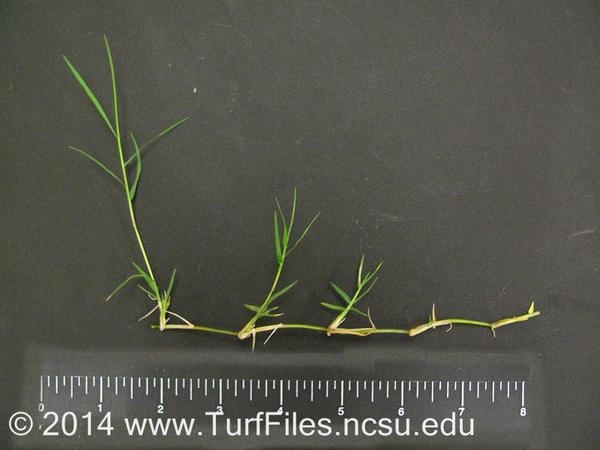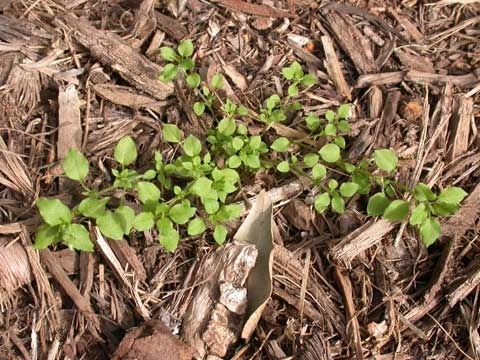Weeds compete with desired plants for water, nutrients, and sunlight. They also harbor insects and diseases, and reduce harvest overall. Weed seeds can be blown into a garden by wind, washed in by stormwater, or deposited in bird or animal feces. Weed seeds can be carried on clothing, shoes, tools, or gardening equipment, including rototillers or mowers. Weed seeds can also be introduced with purchased plants, topsoil, or compost.
As weeds can grow vigorously and use available resources efficiently, they can out-compete other plants. As a general rule, remove any weeds growing within 3 feet of the plants you are growing to prevent them from competing with your desired fruits and vegetables.
General Strategies for Weed Management
Prevent weeds from reproducing by removing them while they are young, before they bloom and set seed.
Weeds can be divided into four types based on plant life cycle:
- Winter annuals: Germinate in the fall or early spring when soil temperatures are cool. They flower, produce seeds, and die in late spring or summer.
- Summer annuals: Germinate when the soil warms in the spring and summer. They flower, produce seeds, and die in late summer or fall.
- Biennials: Germinate from seed and produce a cluster (rosette) of leaves near the soil surface during the first year of growth. During the second year, they flower, produce seeds, and die.
- Perennials: Grow for many years, producing seeds annually.
Use the Integrated Weed Management strategies below to manage weeds with minimal inputs and as few adverse environmental effects as possible.
Cultural
- Remove all weeds prior to planting the crop.
- Use transplants instead of seeds to give the plant a head start on the weeds.
- Use high-quality seeds, adapted varieties, and proper plant spacing that leads to canopy closure. These methods will shade out weeds.
- Optimize crop health through proper fertilization, pest management, and drip or trickle irrigation.
- Plant winter and summer cover crops such as clover, vetch, or annual ryegrass between garden rows and between crop cycles to suppress weeds.
Mechanical
- Apply mulch (the most common and reliable material for preventing annual weed emergence, preventing light from reaching weed seeds).
- Install root barriers around the perimeter of the garden to prevent underground spread by nearby perennial weeds.
- Hoe carefully to avoid damaging the roots or stems of desired plants.
- Hand-pull weeds when they are young and the soil is moist, and remove them from the site to prevent them from rerooting.
Biological
- Use natural enemies such as insects, nematodes, bacteria, fungi, or animals to keep weeds in check.
Chemical
- Chemical management is not recommended for production gardens in early childcare centers.
Weed Management Throughout the Year
- Winter: Around perennial crops (such as fruit trees and caneberries), apply 3 to 4 inches of mulch to the planting bed to prevent weeds from germinating in the spring. Hand-weed winter weed seedlings as they emerge.
- Spring: Hand-pull weeds when they are small. If you choose to use a chemical management strategy, apply a preemergence herbicide before summer annual weed seeds germinate. This affects all seeds, vegetable as well as weed seeds. Emerged weeds can be burned by a flame weeder or a herbicide applied before planting.
- Summer: Continuously hand-pull, mow, or prune foliage of weeds. This reduces the leaf surface area that can produce food for underground storage and also removes reproductive parts (flowers and seeds). Remove weeds before they flower or produce seeds. This will help reduce the number of weeds emerging the following year.
- Fall: Hand-pull weeds and remove underground storage organs (like tubers or rhizomes). Mulch around fall-planted crops to prevent winter annual weeds.
For more information on weed management and weed life cycles, see the "Weeds" chapter in the North Carolina Extension Gardener Handbook.
Four Most Common Weeds Found in Production Gardens
Bermudagrass (wiregrass)
- Weed identification: A perennial, aggressive, grass weed.
- How the weed spreads: Underground rhizomes, above-ground wiry stolons, and seeds.
- Weed management: Small patches can be dug out but all parts of the root must be removed. Do not rototill live plants because each piece is capable of rerooting and forming a new plant. Remove before it goes to seed.
Common Chickweed
- Weed identification: This cool-season winter annual has smooth stems and leaves with light green egg-shaped opposite leaves and star-shaped, divided five-petal, white flowers. It grows in partial shade to full sun.
- How the weed spreads: Seeds germinate in fall to spring, forming dense green mats. It sets flowers and seeds at the same time and can spread rapidly.
- Weed management: Hand-pull when the soil is moist.
Nutsedge
- Weed identification: Sedges are similar to grasses but they have triangular, solid stems, leaves that occur in threes, and can be 2½ feet tall. These perennial plants die back to the ground in fall, with new shoots emerging in spring from underground tubers. Sedges grow best in wet sites and prefer warm weather and full sun but will grow in a variety of conditions.
- How the weed spreads: Underground rhizomes and tubers.
- Weed management: Nutsedge is difficult to hand-weed because of the underground rhizomes and tubers. However, a whole class of children pulling it up as soon as it is seen will gradually starve the plant since it is not given time to photosynthesize and replenish the food stored in the rhizomes.
Yellow woodsorrel (oxalis, sourgrass)
- Weed identification: This perennial has three heart-shaped leaflets, a shallow taproot, rhizomes, and hairy stems that are 4 to 10 inches tall. The flowers are bright yellow with five petals. Creeping woodsorrel, a close relative, is nearly identical but spreads by stolons and seeds.
- How the weed spreads: Spreads by seeds, rhizomes, and stolons. An interesting note: The seed pods forcefully expel seeds up to 12 feet. This can be a fun teaching opportunity with students.
- Weed management: Weed by hand.
Fun With Weeds
Books
- Flip, Float, Fly: Seeds on the Move by JoAnn Early Macken
Videos
- "Weeds Find a Way." Simon & Schuster Books. February 14, 2014. Video.
Activities
- Weeding in the Garden, from the Appalachian Sustainable Agriculture Project
Additional Resources
- The Natural Learning Initiative
- North Carolina Extension Gardener Handbook
- Extension Gardener Plant Toolbox
- NC State Extension Gardening
- Chapter 6: Weeds
- Weed Identification Guide, from Virginia Tech
- Garden Help Directory — Contact the local N.C. Cooperative Extension center in your county.
Acknowledgments
Funding for this publication was provided in part by the John Rex Endowment.
The authors would like to thank Melissa Bell, Research Associate, Center for Environmental Farming Systems Field Research, Education and Outreach Liaison, NC State University, for their management of the review process.
This publication was developed in partnership with the Natural Learning Initiative in the College of Design at North Carolina State University.
About the Local Foods Series: Childcare Center Production Gardens
This publication in the Local Foods series is one of 15 publications about childcare center production gardens:
- Growing and Cooking Fruits and Vegetables at Childcare Centers (LF-007-01)
- Creating Childcare Center Production Gardens (LF-007-02)
- Growing Warm-Season Fruits and Vegetables in Childcare Production Gardens (LF-007-03)
- Growing Cool-Season Vegetables in Childcare Production Gardens (LF-007-04)
- Snacking and Cooking with Warm-Season Produce from Childcare Production Gardens (LF-007-05)
- Snacking and Cooking with Cool-Season Produce from Childcare Production Gardens (LF-007-06)
- Composting in Childcare Center Production Gardens (LF-007-07)
- Vermicomposting in the Childcare Center Production Gardens (LF-007-08)
- Introducing Children to Insects in Childcare Center Gardens (LF-007-09)
- Easy Fruits to Grow at Childcare Center Gardens (LF-007-10)
- Growing Strawberries in Childcare Center Gardens (LF-007-11)
- Managing Weeds in Childcare Center Gardens (LF-007-12)
- Growing Fruit Trees in Childcare Center Gardens (LF-007-13)
- Growing Muscadines in Childcare Center Gardens (LF-007-14)
- Growing Blueberries in Childcare Center Gardens (LF-007-15)
Publication date: July 27, 2023
LF-007-12
N.C. Cooperative Extension prohibits discrimination and harassment regardless of age, color, disability, family and marital status, gender identity, national origin, political beliefs, race, religion, sex (including pregnancy), sexual orientation and veteran status.














